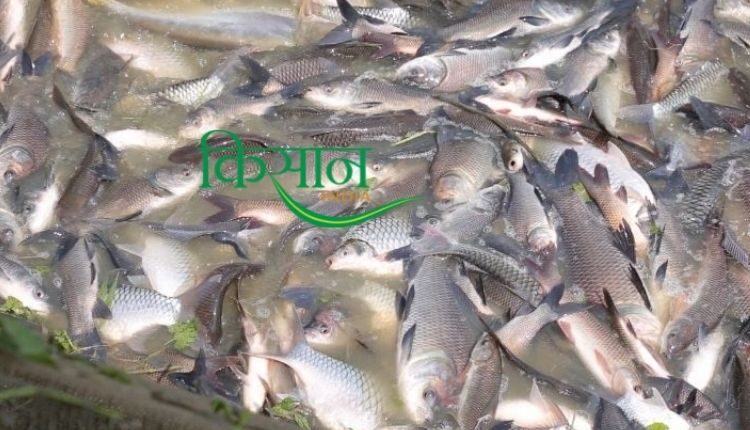Biofloc Fish Farming In India: New techniques keep getting invented in every field related to farming and agriculture. One such new technology in the field of fish farming is Biofloc, in which the waste of fish is converted back into feed. If you are thinking about fish farming, but you do not have enough land to build a pond, then Biofloc technology is right for you, because in this you can do fish farming in a tank. The Fisheries Department established the first fish farm with Biofloc technology in Pathariya (Doma) village of Durg district of Chhattisgarh. 15 thousand Tilapia fish are being reared here. Sweety Singh, the inspector of this fish farm, spoke openly about the new technique of fish farming i.e. biofloc fish farming with Aishwarya Srivastava, correspondent of Kisan of India.
Why was biofloc fish farming technique adopted?
Sweety Singh says that the purpose of starting biofloc in Pathariya village is to provide more employment to the villagers and make them self-reliant. She informs to start fish farming, fish were first brought from Kolkata and by keeping them in the farm, it was first observed how they adapt to the new environment. After that, the fish were put in the tank here and after that a total of 15 thousand fish were brought in 60 tanks.
What is biofloc technology?
Sweety Singh tells about the biofloc fish farming technique that actually, it is a process in which the nitrogen cycle has to be maintained, the principle of this technique is that the nitrogen cycle should be maintained inside the fish tank. Fishes excrete 75% of the food they eat as waste, due to which the amount of ammonia increases in the tank or any system, this ammonia is harmful for fishes.
Therefore, there is a process to convert this ammonia into nitrogen which is called flocculation or nitrogen cycle, the product obtained from this process is called floc, so first jaggery is added to it as a source of carbon and ammonia is used for nitrogen and some probiotics, bacteria and some yeast are added to it. Bacteria and yeast convert ammonia into nitrogen and the good bacteria that develop convert it into floc which the fish eat. This floc is a mixture of microorganisms and micronutrients which is beneficial for the fishes.
This process of floc formation continues. The fishes will eat the floc and excrete waste and then the process of converting ammonia into nitrogen will take place and flocs will be formed again. The main purpose of biofloc technology is recycling of waste. In this, bacteria keep purifying the water, which means less water is required. This system has double benefits, fish get protein in the form of flock and water also gets purified. It is an excellent technique to save less space, water and food for fish.
Selection of fish species in biofloc technology
Sweety tells that since biofloc is a tank system, fish of a little hard species should be reared in it, which means that they can tolerate changes in temperature and pH. Hardy fish can be air breathing and non air breathing fish, it should just be a little strong so that it can tolerate changes in environment and pH etc. At present, tilapia fish is being reared in the fish farm of Pathariya village, but you can also rear Pangasius in it.
What things are needed to start biofloc?
Sweety Singh, inspector of fisheries department, says that availability of water and electricity is the first requirement to start biofloc system. When he started working here, both things were available. But the soil here was wet, which would stick to the feet, making it difficult to operate the system, so first it was leveled and then the tank was set up, which took 2-3 months. Then the tank was filled with water for 5-6 days, and it was seen that the water was hard.
Then an attempt was made to make it normal by adding lime etc. After that, some fish were brought in and it was seen whether they could adjust here or not. First, fish were brought from Kolkata and kept for 15 days and it was seen whether they could adjust to the new temperature and environment or not. After that, a large number of fish were brought.
Lower feed cost
The cost of feed is lower in biofloc technology. Sweety says that the feed we add during fish culture is the biggest cost. About 60% of the total input cost is spent on feed, so the best way to reduce it is biofloc technology. Because it recycles waste. In this, the fish eat the floc, which reduces the consumption of external feed and this automatically reduces the cost. Also, in this technology, you can inspect daily. You can see from outside whether the fish are eating the grain or not, that is, it is known whether they are healthy or not.
Water requirement in the tank
For fish farming, at least 5-6 feet of water has to be filled in the pond, but in biofloc technology, only 1.2 feet of water needs to be filled in the tank, because the depth of the tank is only one and a half feet. In this, the same water is filtered and used again and again, so that water is not wasted.
How much time does it take to bring the fish and put them in the tank?
Sweety tells that first of all we fill the tank with water, then we have to add inoculum to make the flock. To make it, a little urea, jaggery (carbon-hydrogen source), salt (to maintain TDS level), yeast, probiotic and probiotic activate are mixed so that beneficial bacteria can grow. Then it is left for 5-6 days so that the yeast can develop. If you put this mixture in water, the flock will develop after 6-7 days, the flock is checked with the help of an instrument. This entire process takes about 20 days. Fish are put in the tank only after the flock develops.
Method of tank setup
First the base is prepared, then the virus mess (in round shape) is made, tarpaulin has to be made on top of it. 4 aerators have to be set, which maintain the oxygen level. Fill 1.2 feet of water in the tank and leave it for 3-4 days, if for some reason there is a foul smell, remove it and fill it again. Then add inoculum, it takes 7 days for the floc to develop, after that add the fish.
Keep these things in mind in biofloc technology
It can be started on your own land or by taking land on lease.
The land should not be near a river or drain, it should not get submerged in flood.
There should be a bore and pump on the land (5 HP pump).
There should be money to buy the necessary equipment.
Subsidy in biofloc technology
Farmers get subsidy for biofloc technology. For this, they can contact the fisheries department with the land documents. They will get 40 percent subsidy if they belong to OBC and General category. SC and ST category people get up to 60 percent subsidy.
How to clean the fish tank?
Sweety Singh says that there is no need to change the tank water, but yes, sometimes if the floc is not able to develop or the water becomes very dirty and you feel that it needs to be changed, then there is an outlet in the center of the tank, open it and all the water will come out.
Parameters for water
It is important to take care of some parameters of water for proper fish farming in biofloc technology. Regarding this, Sweety Singh says that the most important thing is that the dissolved oxygen (DO) level can be 5-6 or 6-8, but 6-8 is the best, so it should be maintained. For this, it can be maintained by increasing or decreasing the aerator. It is also important to maintain the TDS level. It should be 300-600 milligrams per liter. An instrument has been provided to check the temperature, through which it can be checked. The temperature should be 25-35 degrees. Ammonia should be below 0.01.
Cost and earnings in Biofloc technology
Sweety Singh tells about the initial cost and profit that it takes at least 1.5 lakhs to start it. After 6 months of culture, you start earning. A fish of 20-30 grams weighs up to 500 grams in 6 months. So if you put 7 thousand fishes and even if 3 thousand of them survive, then you can earn up to 1.5 lakh rupees a month. But if you are a professional fish farmer, then you can earn up to 3 lakh rupees a month.
Contact us – If farmers want to share any valuable information or experiences related to farming, they can connect with us via phone or WhatsApp at 9599273766 or you can write to us at “[email protected]”. Through Kisan of India, we will convey your message to the people, because we believe that if the farmers are advanced then the country is happy.
You can connect with Kisan of India on Facebook, Twitter, and WhatsApp and Subscribe to our YouTube channel.



